You're using an outdated browser. Please upgrade to a modern browser for the best experience.
Please note this is a comparison between Version 2 by Catherine Yang and Version 3 by Catherine Yang.
Approximately 356 species of turtles inhabit saltwater and freshwater habitats globally, except in Antarctica. Twenty-four species of turtles have been reported in Malaysia, four of which are sea turtles. The state of Terengganu harbored the highest number of turtles, with 17 different reported species.
- taxonomic
- sea turtles
- IUCN Red List
- CITES
1. Introduction
There are approximately 356 turtles living on land on every continent, except for in Antarctica, as well as in salt water and fresh water [1]. The term “turtle” is frequently used to refer to sea turtles, which only rarely leave the sea [2]. Sea turtles belong to the Cheloniidae families, except for the Leatherback turtle, which is the only genus in the Family Dermochelyidae and has a leathery carapace [3]. The seven species of sea turtles are Green turtle (Chelonia mydas), Hawksbill turtle (Eretmochelys imbricata), Leatherback turtle (Dermochelys coriacea), Loggerhead turtle (Caretta caretta), Flatback turtle (Natator depressa), Olive ridley turtle (Lepidochelys olivacea), and Kemp’s ridley turtle (Lepidochelys kempii) [4]. Malaysia is home to four sea turtle species: the Leatherback turtle, the Green turtle, the Olive ridley turtle, and the Hawksbill turtle [5]. With nearly 40% of its total body mass made up of bone, the turtle is possibly the most organized form of animal armor ever to appear [6]. As a result, this great armor is most likely why turtles appeared on the scene over 200 million years ago and miraculously survived the extinction of the dinosaurs and other devastating events [6].
In Testudines’ order, turtles are any reptile with a hard shell around its body, including tortoises [7]. They have anatomical characteristics that set them apart from other turtles. In the Chelonia order, a turtle, a tortoise, and a terrapin are all names for hard-shelled egg-laying reptiles [8]. However, the specific expression used for a particular turtle can vary depending on its natural surroundings. For example, the term “turtle” usually refers to turtles that have spent their entire lives in or near water [9]. The term “tortoise” is commonly used to refer to turtles that spend most of their time ashore, eating bushes, grass, and fruit [10]. Unlike other turtle family members, tortoises do not have webbed feet because they do not spend much time in the water [11]. Terrapins are turtles that invest energy in fresh and brackish water [12]. “Terrapin” is derived from an Algonquian Indian word that means “a small turtle” [13]. Malaysia is home to 20 different kinds of turtles. Two of them, Pelodiscus sinensis and Trachemys scripta, were brought there from other places [14]. In total, Malaysia has 24 different species of turtles [15].
2. Turtle Types in Malaysia
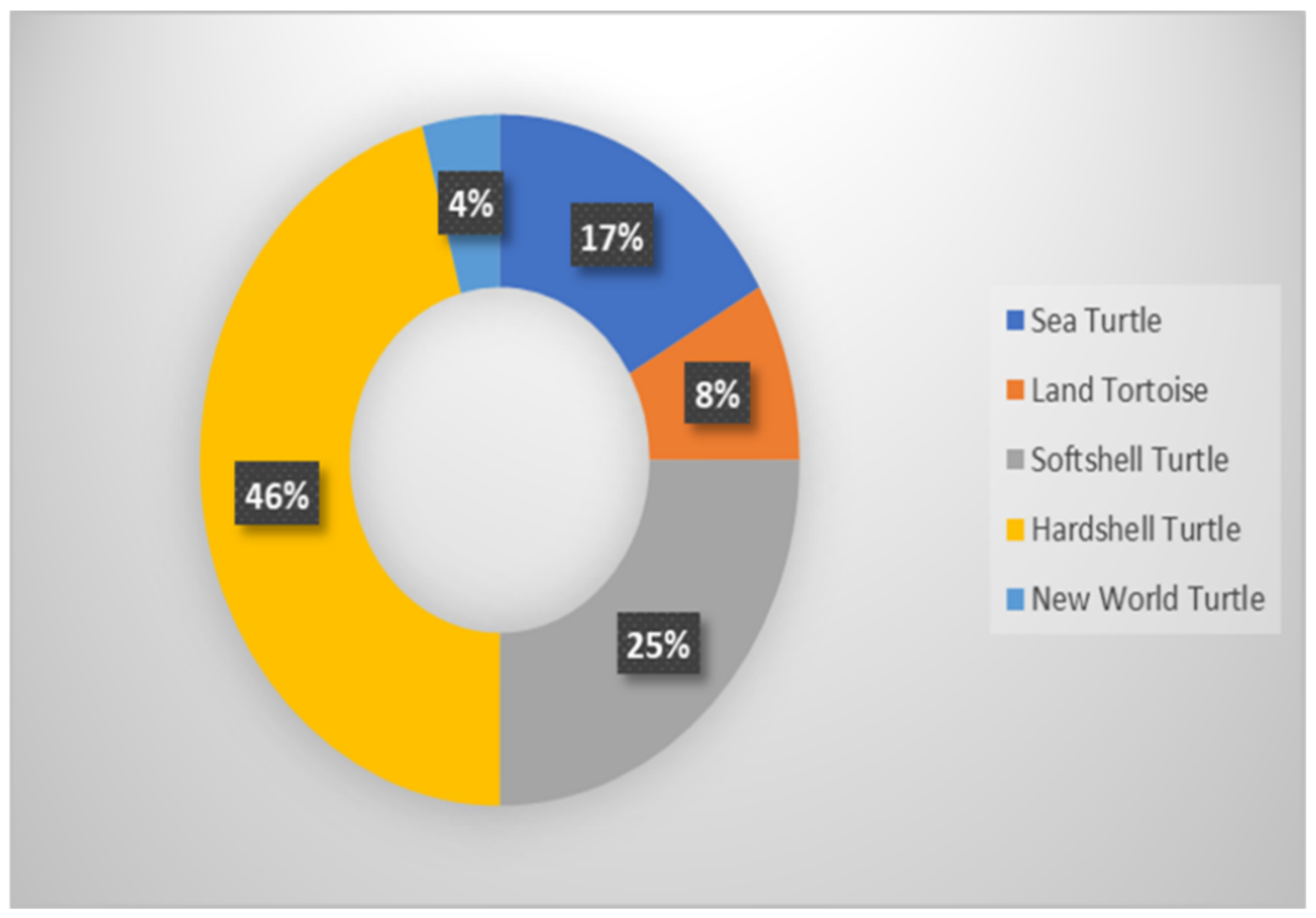
Figure 1. The diversity of turtles in Malaysia.
Actinemys
, Chrysemys
, Clemmys
, Deirochelys
, Emydoidea
, Emys
, Glyptemys
, Graptemys
, Malaclemys
, Pseudemys
, Terrapene
, and Trachemys
[31]
. Except for Trachemys
, which is found in South America and the West Indies, and Emys
, which inhabits Southern Europe, Northern Africa, and Western Asia, all of these species are restricted to North America [32]
. The relationships between the 12 genera and the species that make up the family are yet unknown [33]
.
3. Conservation Status
3.1. The Status of the IUCN Red List
The IUCN Red List categorizes species into nine groups (Table 1), which Reference [34] defined based on population size, rate of decline, geographic distribution area, fragmentation distribution, and population degree. The importance of applying any measures without extensive information, including suspicion and potential future threats, is emphasized “so long as these can reasonably be supported” [35]. The “Threatened” category includes “Critically Endangered”, “Endangered”, and “Vulnerable” [36] on its Red List. Table 2 shows that Malaysia has 24 turtle species, four of which are sea turtles, and the other 20 are freshwater turtles (two of which are introduced species) [14][37]. According to the IUCN Red List, a sea turtle (Eretmochelys imbricata) and six freshwater turtle populations (Manouria emys, Batagur affinis, Orlitia borneensis, Batagur borneoensis, Indotestudo elongata, and Chitra chitra) are critically endangered in Malaysia (Figure 2). In contrast, a sea turtle (Chelonia mydas) and five freshwater turtles (Heosemys annandalii, Cuora amboinensis, Heosemys spinosa, Chitra indica, and Pelochelys cantorii) were endangered in Malaysia. Two sea turtles (Dermochelys coriacea and Lepidochelys olivacea) and six freshwater turtles were vulnerable (Malayemys macrocephala, Notochelys platynotan, Siebenrockiella crassicollis, Amyda cartilaginea, Manouria iimpressa, and Pelodiscus sinensis). However, two sea turtles were reported by Reference [38] in The ASEAN Post; a source from the World Wildlife Foundation (WWF) Malaysia shows that the Leatherback turtle is critically endangered, and the Olive Ridley turtle is endangered in the Malaysian ocean. Moreover, one species, Cyclemys dentata, is near threatened, and two species, Dogania subplana and Trachemys scoundaripta, are less concerned. All the turtle species are distributed all over Malaysia. However, Terengganu is home to 17 species, including four species of sea turtles (Chelonia mydas, Dermochelys coriacea, Lepidochelys olivacea, and Eretmochelys imbricata) and 13 species of freshwater turtles (Trachemys scripta, Batagur affinis, Batagur borneonsis, Coura amboinensis, Siebenrockiella crassicollis, Manouria emys, Amyda cartilaginea, Dogania subplana, and Pelochelys cantorii) [14]. In addition, referring to Figure 3, the IUCN Red List analysis shows that 29 percent of Malaysia’s turtle species are critically endangered and 25 percent are endangered.| Classification | Describtion |
|---|
40].
Table 2. Checklist of Turtle Species in Malaysia [36][
| Green Turtle | |||||
| Chelonia mydas | |||||
| MN124278 | |||||
| EN | I | [ | 46 | ] | |
| Asian Giant Softshell Turtle | Pelochelys cantorii | HQ329785 | EN | II | [41] |
| Indian Narrow-headed Softshell Turtle | Chitra indica | HQ329771 | EN | II | [41] |
| Malaysian Box Turtle | Cuora amboinensis | JN860217 | EN | II | [45] |
| Spiny Turtle | Heosemys spinosa | HQ329684 | EN | II | [41] |
| Yellow-headed Temple Turtle | Heosemys annandalii | HQ329681 | EN | II | [41] |
| Leatherback Turtle | Dermochelys coriacea | KU883273 | VU | I | [47] |
| Olive Ridley Turtle | Lepidochelys olivacea | KF894766 | VU | I | [48] |
| Asiatic Softshell Turtle | Amyda cartilaginea | HQ329768 | VU | II | [41] |
| Black Marsh Turtle | Siebenrockiella crassicollis | HQ329704 | VU | II | [41] |
| Impressed Tortoise | Manouria impressa | GQ867670 | VU | II | [49] |
| Malayan Flat-shelled Turtle | Notochelys platynota | HQ329692 | VU | II | [41] |
| Malayan Snail-eating Turtle | Malayemys macrocephala | HQ329686 | VU | II | [41] |
| Chinese Softshell Turtle | Pelodiscus sinensis | JQ844545 | VU | None | [50] |
| Asian Leaf Turtle | Cyclemys dentata | HQ329676 | NT | II | [41] |
| Malayan Softshell Turtle | Dogania subplana | NC_002780 | LC | II | [51] |
| Yellow-bellied Slider Turtle | Trachemys scripta | JF700194 | LC | None | [52] |
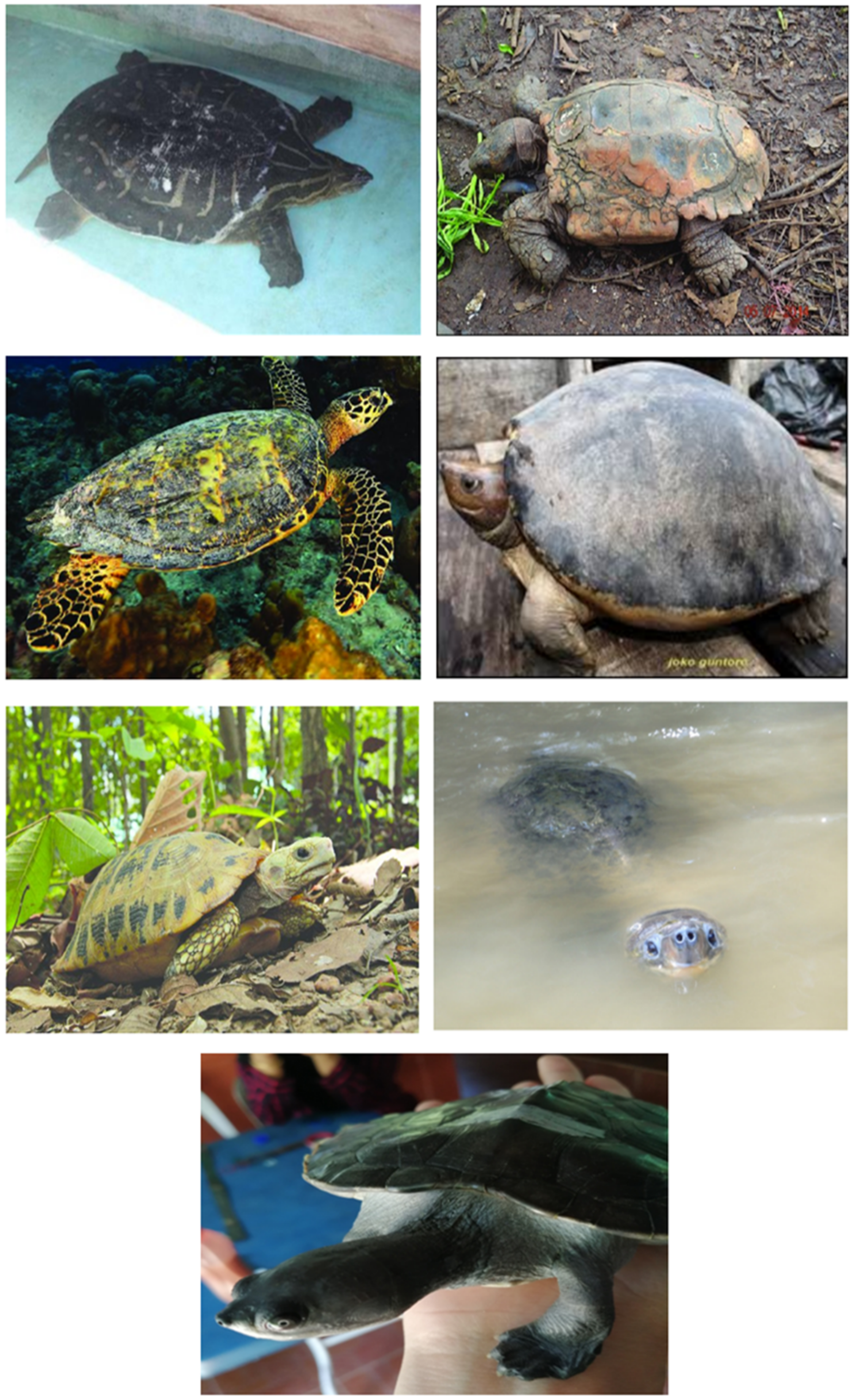
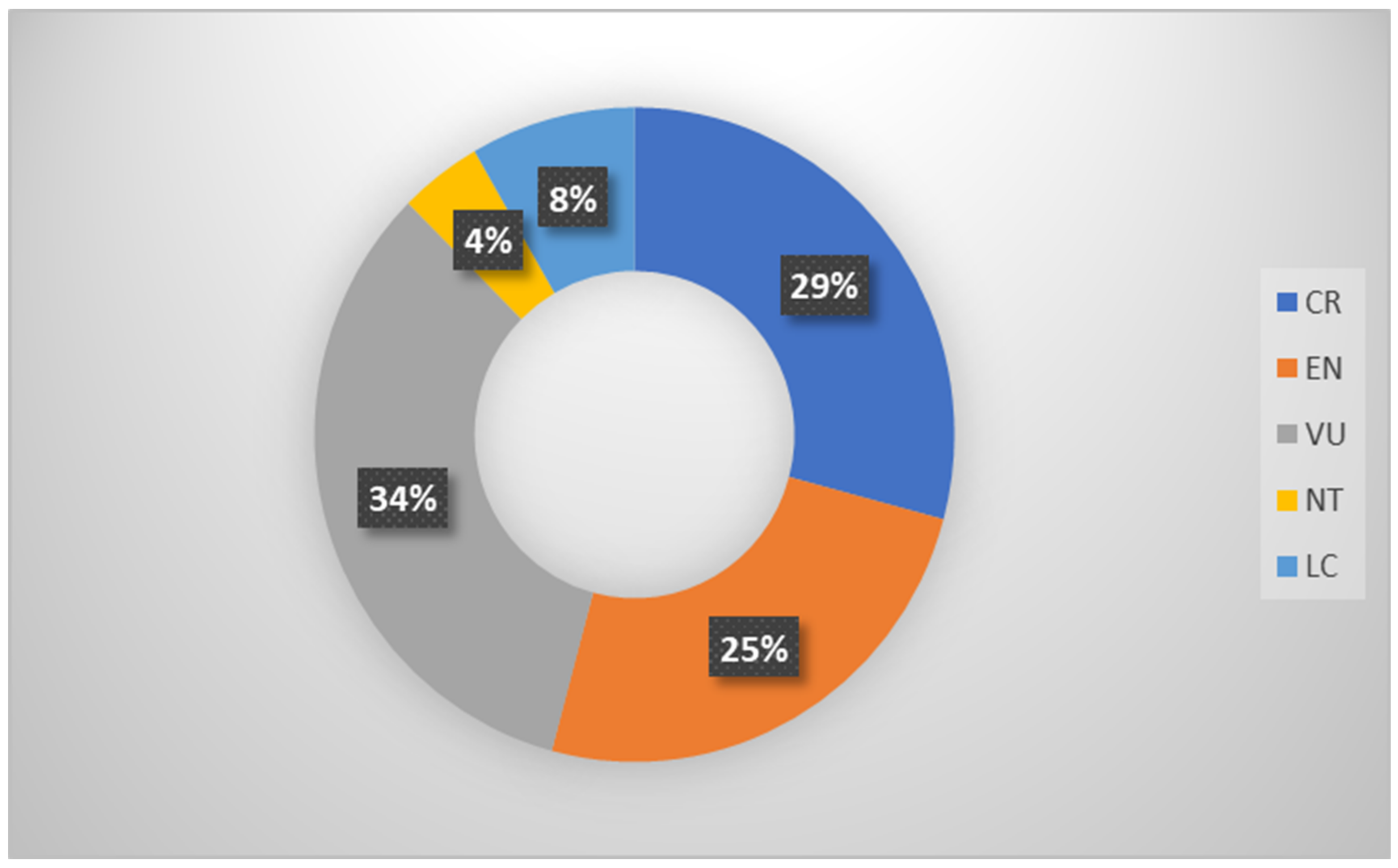
Figure 3. Chart of IUCN Red List status on turtles.
3.2. The CITES Appendices
The Convention’s Appendices I, II, and III are lists of species with different levels of protection from over-exploitation [60]. Appendix I lists the most endangered plants and animals on the CITES list. They are almost extinct, but CITES allows international trade in specimens of these species as long as the import is not for commercial use (i.e., a scientific research study) [61]. In Appendix II, there is a list of species that are not threatened with extinction right now, but if the trade is not controlled, there is a high chance that they will be in the future. It also includes supposed “similar species”, such as species whose standards in exchange resemble species recorded for conservation purposes. Trade-in specimens of Appendix-II species may be authorized by issuing an export permit or re-export permit certificate. No import permit is necessary for these species under CITES (although a permit is needed in some countries with stricter measures than CITES requires) [62]. Appendix III contains a list of species added at the request of a party that already regulates international trade in the species. Specimens of the species in this appendix can be traded around the world only if the proper permits or certificates are shown [60]. An analysis of Figure 4 reveals that CITES has classified Malaysian turtles as 67 percent threatened, including Manouria emys, Orlitia borneensis, Batagur borneoensis, Indotestudo elongate, Heosemys annandalii, Cuora amboinensis, Heosemys spinosa, Chitra indica, Pelochelys cantorii, Malayemys macrocephala, Notochelys platynotan, Siebenrockiella crassicollis, Amyda cartilaginea, Manouria impressa, Cyclemys dentata, and Dogania subplana. About 25% (Batagur affinis, Chitra chitra, Eretmochelys imbricata, Chelonia mydas, Dermochelys coriacea, and Lepidochelys olivacea) are the most endangered species.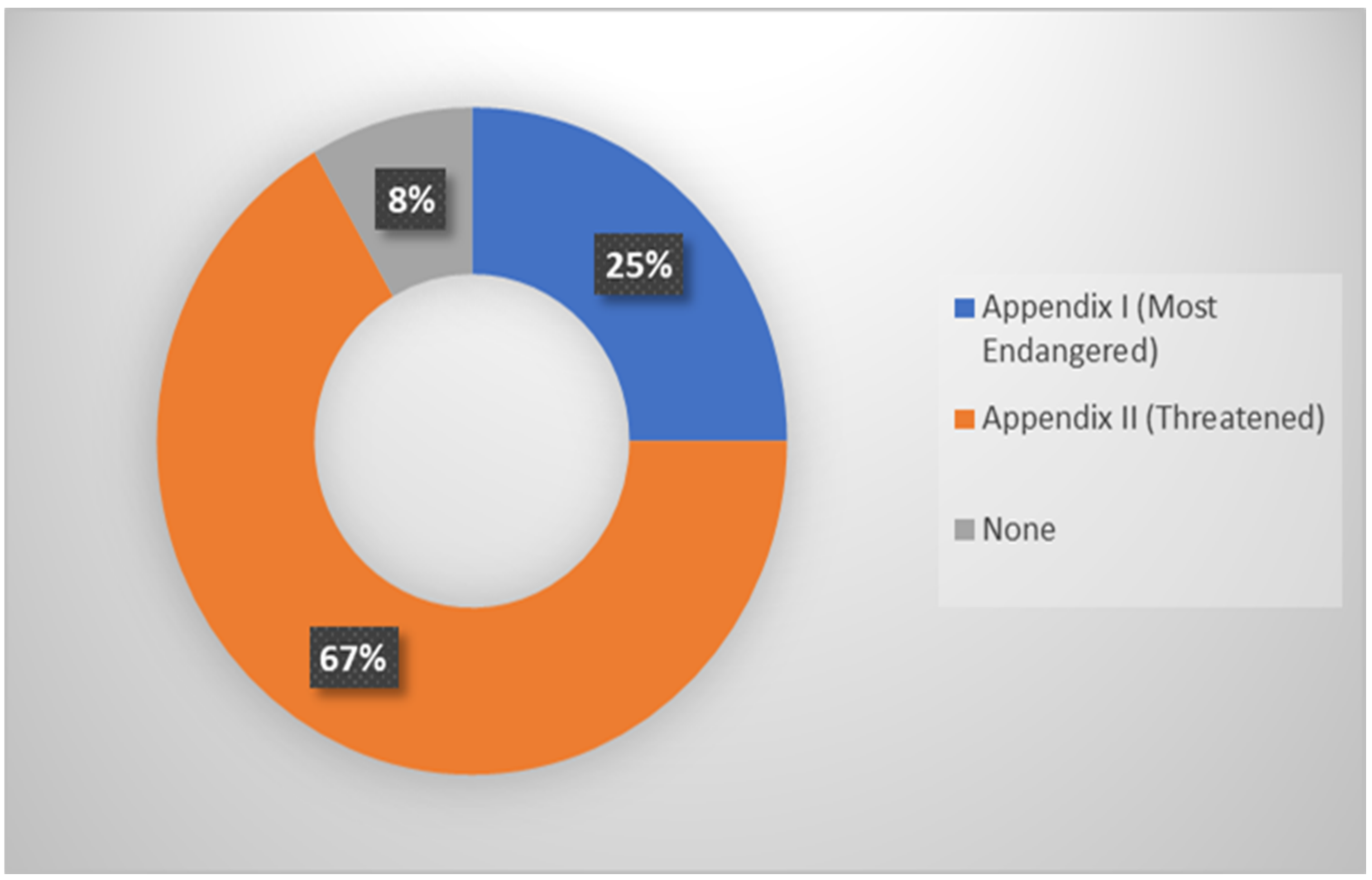
Figure 4. Chart of CITES’s appendices on turtles.
4. Threat Factors
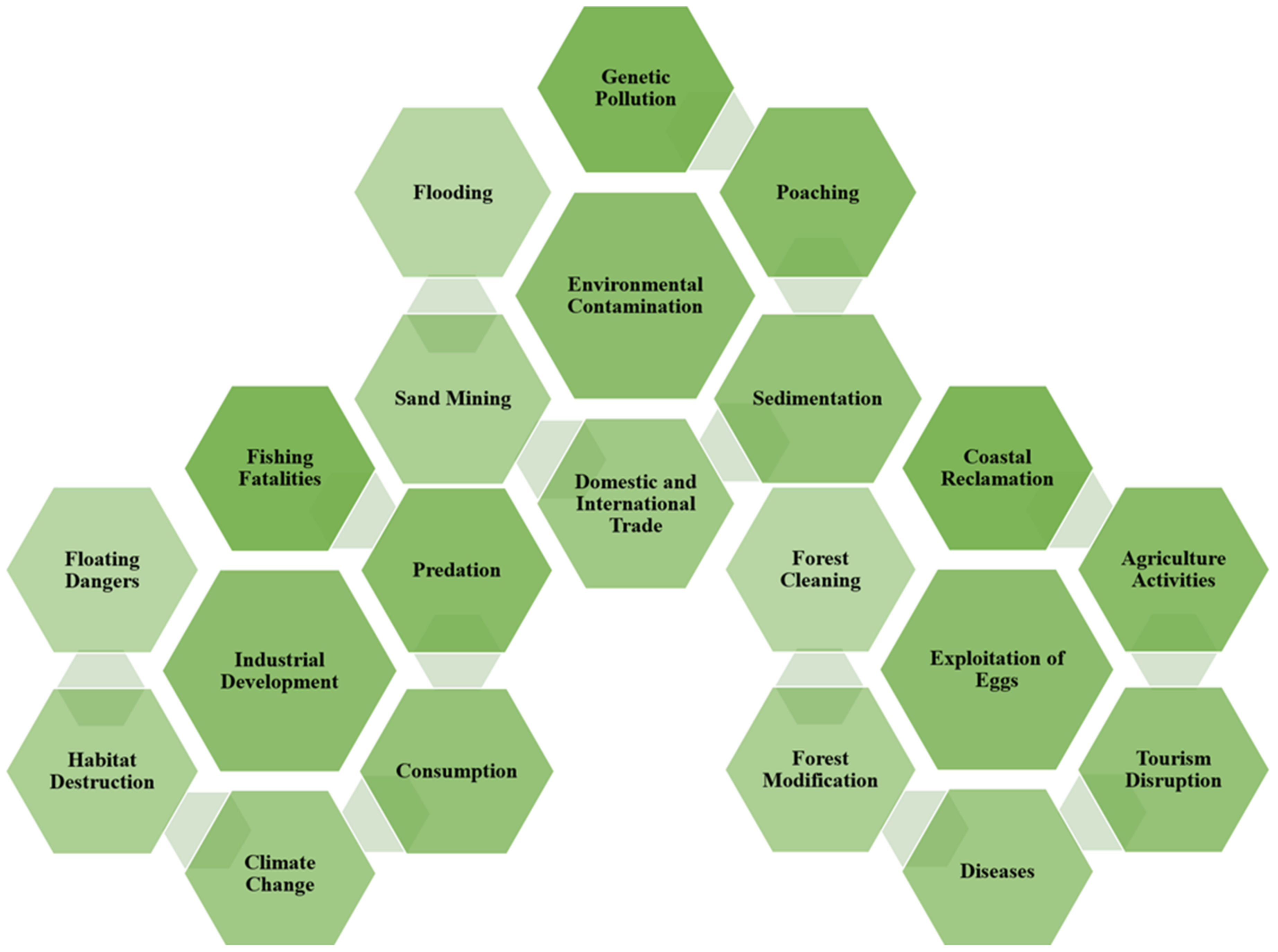
Figure 5. These threat factors were compiled from IUCN data, the DOF Report, DWNP Report, TRAFFIC South-east Asia Report, species-recovery plans, federal-agency re-sponses, and miscellaneous publica-tions on species’ life history. A complete list of documents used to assign biological attributes to endangered species is available from the authors.
References
- Forero-Medina, G.; Páez, V.P.; Garcés-Restrepo, M.F.; Carr, J.L.; Giraldo, A.; Vargas-Ramírez, M. Research and conservation priorities for tortoises and freshwater turtles of Colombia. Trop. Conserv. Sci. 2016, 9, 3708.
- Lau, M.M.; Ruqaiyah, S.; Devadasan, A.; Duraisingham, G.S.; Zulkifli, R. Satellite tracking of Green turtles and Hawksbill turtles in Peninsular Malaysia by WWF-Malaysia. In Report on the Third Technical Consultation on Research for Stock Enhancement of Sea Turtles (Japanese Trust Fund IV Program); World Wildlife Fund: Petaling Jaya, Selangor, Malaysia, 2009; pp. 101–114.
- Peters, M.E. Identification and taphonomy of a Miocene Leatherback Turtle (Testudines: Dermochelyidae) from the Westerschelde. Master’s Thesis, Utrecht University, Utrecht, The Netherlands, 2018.
- Chan, E.H. Marine turtles in Malaysia: On the verge of extinction? Aquat. Ecosyst. Health Manag. 2006, 9, 175–184.
- Chan, E.H.; Liew, H.C. The Leatherback Turtle-A Malaysian Heritage; Tropical Press Sdn. Bhd.: Kuala Lumpur, Malaysia, 1989.
- Ernst, C.H.; Lovich, J.E. Turtles of the United States and Canada; Johns Hopkins University Press: Baltimore, MD, USA, 2009.
- Zug, G.R. Turtle. Encyclopædia Britannica. Available online: https://www.britannica.com/animal/turtle-reptile (accessed on 2 March 2022).
- Gollmann, G. Turtles: The Animal Answer Guide. Amphib. Reptil. 2011, 32, 293.
- Wyneken, J.; Lutz, P.L.; Musick, J.A. Sea turtle locomotion: Mechanisms, behavior, and energetics. In The Biology of Sea Turtles; Taylor & Francis Group (CRC Press): London, UK, 1997; pp. 165–198.
- Branch, B. Tortoises, Terrapins & Turtles of Africa; Penguin Random House South Africa: Cape Town, South Africa, 2012.
- Buhlmann, K.; Tuberville, T.; Gibbons, J.W. Turtles of the Southeast; University of Georgia Press: Athens, GA, USA, 2008.
- Jualaong, S.; Songnui, A.; Thongprajukaew, K.; Ninwat, S.; Khwanmaung, S.; Hahor, W.; Khunsaeng, P.; Kanghae, H. Optimal salinity for head-starting Northern river terrapins (Batagur baska Gray, 1831). Animals 2019, 9, 855.
- Speck, F.G. Reptile lore of the Northern Indians. J. Am. Folk. 1923, 36, 273–280.
- Ibrahim, N.S.; Sham, B.H.B.; Shafie, N.J.; Ahmad, A. Species Diversity of Freshwater Turtles and Tortoises in Terengganu, Malaysia. J. Sustain. Sci. Manag. 2018, 1, 1–27.
- Aun, P.K. Malayan testudines. J. Wildl. Parks 1990, 9, 20–31.
- Bowen, B.; Avise, J.C.; Richardson, J.I.; Meylan, A.B.; Margaritoulis, D.; Hopkins-Murphy, S.R. Population structure of loggerhead turtles (Caretta caretta) in the northwestern Atlantic Ocean and Mediterranean Sea. Conserv. Biol. 1993, 7, 834–844.
- Duchene, S.; Frey, A.; Alfaro-Núñez, A.; Dutton, P.H.; Gilbert, M.T.P.; Morin, P.A. Marine turtle mitogenome phylogenetics and evolution. Mol. Phylogenet. Evol. 2012, 65, 241–250.
- Robinson, N.J.; Paladino, F.V. Sea Turtles, Reference Module in Earth Systems and Environmental Sciences; Elsevier: Amsterdam, The Netherlands, 2013; pp. 1–13.
- Nick, B. Turtles of Southeast Asia. Available online: https://www.ecologyasia.com/verts/turtles.htm (accessed on 20 March 2021).
- Böhme, M.; Vasilyan, D. Ectothermic vertebrates from the late Middle Miocene of Gratkorn (Austria, Styria). Palaeobiodivers. Palaeoenviron. 2014, 94, 21–40.
- Stanford, C.B.; Iverson, J.B.; Rhodin, A.G.; van Dijk, P.P.; Mittermeier, R.A.; Kuchling, G.; Berry, K.H.; Bertolero, A.; Bjorndal, K.A.; Blanck, T.E.; et al. Turtles and tortoises are in trouble. Curr. Biol. 2020, 320, R721–R735.
- Ferronato, B.O.; Morales, V.M. Biology and conservation of the freshwater turtles and tortoises of Peru. IRCF Reptiles Amphib. Conserv. Nat. Hist. 2012, 19, 103–116.
- Le, M.; Duong, H.T.; Dinh, L.D.; Nguyen, T.Q.; Pritchard, P.C.; McCormack, T. A phylogeny of softshell turtles (Testudines: Trionychidae) with reference to the taxonomic status of the critically endangered, giant softshell turtle, Rafetus swinhoei. Org. Divers. Evol. 2014, 14, 279–293.
- Pritchard, P.C.H. Carapacial pankinesis in the Malayan softshell turtle, Dogania subplana. Chelonian Conserv. Biol. 1993, 1, 31–36.
- Thomson, S.; Georges, A. A new species of freshwater turtle of the genus Elseya (Testudinata: Pleurodira: Chelidae) from the Northern Territory of Australia. Zootaxa 2016, 4061, 18–28.
- Devi, N.A.; Eprilurahman, R.; Yudha, D.S.; Raharjo, S.; As-Singkily, M.; Gunalen, D.; Arida, E. Genetic diversity and species identity of the critically endangered Rote Island snake-necked turtle, Chelodina mccordi Rhodin. In IOP Conference Series: Earth and Environmental Science; IOP Publishing: Bristol, UK, 2021; Volume 948, p. 012001.
- Rivera, A.R.; Rivera, G.; Blob, R.W. Forelimb kinematics during swimming in the pig-nosed turtle, Carettochelys insculpta, compared with other turtle taxa: Rowing versus flapping, convergence versus intermediacy. J. Exp. Biol. 2013, 216, 668–680.
- Shepherd, C.R.; Gomez, L.; Nijman, V. Illegal wildlife trade, seizures and prosecutions: A 7.5-year analysis of trade in pig-nosed turtles in and from Indonesia. Glob. Ecol. Conserv. 2020, 24, e01249.
- Tuxbury, K.A.; Clayton, L.A.; Snakard, E.P.; Fishman, E.K. Multiple skull fractures in a captive fly river turtle (Carretochelys insculpta): Diagnosis, surgical repair, and medical management. J. Herpetol. Med. Surg. 2010, 20, 11–19.
- Meyer, L.; Du Preez, L.; Verneau, O.; Bonneau, E.; Héritier, L. Parasite host-switching from the invasive American red-eared slider, Trachemys scripta elegans, to the native Mediterranean pond turtle, Mauremys leprosa, in natural environments. Aquat. Invasions 2015, 10, 79–91.
- Plymale, H.H.; Jackson, C.G.G., Jr.; Collier, G. Kyphosis in Chrysemys scripta yaquia (Testudines: Emydidae) and other turtles. Southwest. Nat. 1978, 457–461.
- Fritz, U. Introduction to zoogeography and subspecific differentiation in Emys orbicularis (Linnaeus, 1758). In Proceedings of the EMYS Symposium Dresden, Dresden, Germany, 4–6 October 1998; Volume 96, pp. 1–27.
- Seidel, M.E.; Ernst, C.H. A systematic review of the turtle family Emydidae. Vertebr. Zool. 2017, 67, 1–122.
- Bland, L.M.; Keith, D.A.; Miller, R.M.; Murray, N.J.; Rodríguez, J.P. Guidelines for the Application of IUCN Red List of Ecosystems Categories and Criteria, Version 1.1; International Union for the Conservation of Nature: Gland, Switzerland, 2017; pp. 1–100.
- IUCN RED LIST CATEGORIES AND CRITERIA Version 3.1 Second edition” (PDF). International Union for Conservation of Nature and Natural Resources. 2012. Available online: http://www.iucnredlist.org/documents/redlist_cats_crit_en.Pdf (accessed on 28 February 2022).
- IUCN. The IUCN Red List of Threatened Species. Version 2020-3. 2020. Available online: https://www.iucnredlist.org (accessed on 16 December 2021).
- Lim, B.L.; Indraneil, D. Turtles of Borneo and Peninsular Malaysia; Natural History Publications (Borneo): Kota Kinabalu, Sabah, Malaysia, 1999; p. 151.
- Hasnan, L. Turtles Crying Foul in Malaysia. The Asean Post. Available online: https://theaseanpost.com/article/turtles-crying-foul-malaysia (accessed on 2 June 2019).
- Walker, T. Plant Conservation: Why It Matters and How It Works; Timber Press: Portland, OR, USA; London, UK, 2013; p. 303. ISBN 9781604692600.
- CITES, UNEP-WCMC. The Checklist of CITES Species Website. Appendices I, II and III valid from 04 April 2017. CITES Secretariat, Geneva, Switzerland. Compiled by UNEP-WCMC, Cambridge, UK. 2017. Available online: https://www.cites.org/eng/app/appendices.php (accessed on 1 August 2020).
- Reid, B.N.; LE, M.; McCord, W.P.; Iverson, J.B.; Georges, A.; Bergmann, T.; Amato, G.; Desalle, R.; Naro-Maciel, E. Comparing and combining distance-based and character-based approaches for barcoding turtles. Mol. Ecol. Resour. 2011, 11, 956–967.
- Naro-Maciel, E.; Reid, B.; Fitzsimmons, N.N.; Le, M.; Desalle, R.O.B.; Amato, G. DNA barcodes for globally threatened marine turtles: A registry approach to documenting biodiversity. Mol. Ecol. Resour. 2010, 10, 252–263.
- Çilingir, F.G.; Seah, A.; Horne, B.D.; Som, S.; Bickford, D.P.; Rheindt, F.E. Last exit before the brink: Conservation genomics of the Cambodian population of the critically endangered southern river terrapin. Ecol. Evol. 2019, 9, 9500–9510.
- Kundu, S.; Kumar, V.; Laskar, B.A.; Tyagi, K.; Chandra, K. Pet and turtle: DNA barcoding identified twelve Geoemydid species in northeast India. Mitochondrial DNA Part B 2018, 3, 513–518.
- Kundu, S.; Das, K.C.; Ghosh, S.K. Taxonomic rank of Indian tortoise: Revisit with DNA barcoding perspective. DNA Barcodes 2013, 1, 39–45.
- Ouso, D.O.; Otiende, M.Y.; Jeneby, M.M.; Oundo, J.W.; Bargul, J.L.; Miller, S.E.; Wambua, L.; Villinger, J. Three-gene PCR and high-resolution melting analysis for differentiating vertebrate species mitochondrial DNA for biodiversity research and complementing forensic surveillance. Sci. Rep. 2020, 10, 4741.
- Vella, N.; Vella, A. The first genetic analyses of the leatherback turtle, Dermochelys coriacea from a stranding in central Mediterranean. Rapp. Comm. int. Mer Médit. 2016, 41.
- Kundu, S.; Das, K.C.; Ghosh, S.K. Amino acid analysis of cytochrome c oxidase subunit 1(COI) of Indian testudines’. J. Environ. Sociobiol. 2013, 10, 43–48.
- Xin, C.N. Species Identification of Turtles Using Mitochondrial DNA Markers, 2009; in press.
- Xin, C.N.; Peng, J.J.; Wang, Y.; Wang, L. Application of Cyt b gene as a molecular marker in species identification. Chin. J. Wildlife 2009, 30, 217–221.
- Jeong, T.J.; Jun, J.; Han, S.; Kim, H.T.; Oh, K.; Kwak, M. DNA barcode reference data for the Korean herpetofauna and their applications. Mol. Ecol. Resour. 2013, 13, 1019–1032.
- Farajallah, A.; Suryobroto, B.; Setyadji, R.; Perwitasari-Farajallah, D.; Osamu, T. The Complete Nucleotide Sequence of Malayan Soft-Shelled Turtle (Dogania subplana) Mitochondrial Genome. Available online: https://www.ncbi.nlm.nih.gov/nuccore/AF366350 (accessed on 14 May 2021).
- Zhang, H.; Yao, H.; Cui, L.; DU, H.; Lin, Z.; Gao, X.; Lang, X.; Song, J.; Luo, K.; Shi, L.; et al. Application of COI-based DNA barcoding for identifying animal medical materials in the Chinese pharmacopoeia. World Sci. Technol. Mod. Tradit. Chin. Med. 2013, 12, 371–380.
- Yudha, S.D.; Eprillurahman, R.; Irwanjasmoro; Supramono, Y. Survei Awal Analisa Habitat Ditemukannya Labi-labi Bintang (Chitra chitra) di Sungai Sempor, Sleman, DIY. War. Herpetof. 2019, 6, 1–34.
- Goldberg, S.R.; Mahrdt, C.R. Bogertophis rosaliae: Reproduction. Herpetol. Rev. 2012, 43, 655.
- Friedlander, A.M. Biodiversity and Ecosystem health of the Aldabra Group, Southern Seychelles: Scientific Report to the Government of Seychelles; National Geographic Pristine Seas: Washington, DC, USA, 2015.
- Guntoro, J. The Body Size and Some Field Notes of Painted Terrapin (Batagur borneoensis) in District of Aceh Tamiang, Indonesia. Asian J. Conserv. Biol. 2012, 1, 74–77.
- Ihlow, F.; Dawson, J.E.; Hartmann, T.; Som, S. Conservation Biology of Freshwater Turtles and Tortoises. Indotestudo elongata (Blyth 1854)–Elongated Tortoise, Yellow-headed Tortoise, Yellow Tortoise. Chelonian Res. Monogr. 2017, 5, 1–13.
- Mo, M. Only in captivity?: An interaction between two threatened chelonians, an Asian Giant Tortoise (Manouria emys) and a Malaysian Giant Turtle (Orlitia borneensis). Reptiles Amphib. 2020, 27, 89–90.
- Salleh, M.H.M.; Esa, Y.; Ngalimat, M.S.; Chen, P.N. Faecal DNA metabarcoding reveals novel bacterial community patterns of critically endangered Southern River Terrapin, Batagur affinis. PeerJ 2022, 10, e12970.
- Inskipp, T.; Gillett, H. Checklist of CITES Species and Annotated CITES Appendices and Reservations: A Reference to the Appendices to the Convention on International Trade in Endangered Species of Wild Fauna and Flora; IUCN—International Union for Conservation of Nature: Gland, Switzerland, 2005; Available online: https://policycommons.net/artifacts/1376877/checklist-of-cites-species-and-annotated-cites-appendices-and-reservations/1991140/ (accessed on 22 April 2022).
- Sajeva, M.; Augugliaro, C.; Smith, M.J.; Oddo, E. Regulating internet trade in CITES species. Conserv. Biol. 2013, 27, 429.
- Challender, D.W.; Harrop, S.R.; MacMillan, D.C. Understanding markets to conserve trade-threatened species in CITES. Biol. Conserv. 2015, 187, 249–259.
- Basintal, P.; Lakim, M. Population status and management of sea turtles at the Sabah Turtle Island Park. In Proceedings of the 1st ASEAN Symposium-Workshop on Marine Turtle Conservation, Manila, Philippines, 6–10 December 1993.
- Sharma, D.S.; Tisen, O.B. Freshwater turtle and tortoise utilisation and conservation status in Malaysia. Chelonian Res. Monogr. 2000, 2, 120–128.
- Hendrickson, J.R. The green sea turtle, Chelonia mydas (Linn.) in Malaya and Sarawak. Proc. Zool. Soc. Lond. 1958, 130, 455–535.
- Kalyar, K.; Thorbjarnarson, J.; Thirakhupt, K. An overview of the current population and conservation status of the Critically Endangered River Terrapin, Batagur baska (Gray, 1831) in Myanmar, Thailand and Malaysia. Trop. Nat. Hist. 2007, 7, 51–65.
- Moll, E.O.; Platt, S.G.; Chan, E.H.; Horne, B.D.; Platt, K.; Praschag, P.; Chen, P.N.; van Dijk, P.P. Batagur affinis (Cantor 1847)–Southern River Terrapin, Tuntong. In Conservation Biology of Freshwater Turtles and Tortoises: A Compilation Project of the IUCN/SSC Tortoise and Freshwater Turtle Specialist Group; Rhodin, A.G.J., Pritchard, P.C.H., van Dijk, P.P., Saumure, R.A., Buhlmann, K.A., Iverson, J.B., Mittermeier, R.A., Eds.; Chelonian Res. Monogr: Luneburg, MA, USA, 2015; Volume 5, pp. 1–17.
- Salleh, M.H.B.M.; Sah, S.A.B.M. Morphometric variations in distinguishing sex differences of River Terrapin–Batagur affinis. Malay. Nat. J. 2019, 71, 413–422.
- Salleh, M.H.B.M.; Sah, S.A.B.M. Twenty-First Years Breeding Performance of Southern River Terrapin (Batagur affinis) at Perak River, Peninsular Malaysia. Int. J. Nat. Life Sci. 2019, 3, 52–58.
- Lozano, M.; Baro, J.; García, T.; Frías, A.; Rey, J.; Báez, J.C. Loggerhead sea turtle bycatch data in artisanal fisheries within a marine protected area: Fishermen surveys versus scientific observations. Anim. Biodivers. Conserv. 2011, 34, 31–34.
- Murray, J.P. Testudinidae and Trionychidae (Animalia: Reptilia) in the Pet Trade with Special Emphasis on Indian Star Tortoises (Geochelone elegans) in Peninsular Malaysia. Bachelor’s Thesis, Universiti Malaysia Terengganu, Kuala Terengganu, Terengganu, Malaysia, 2006.
- Chen, P.N. Conservation of the Southern River Terrapin Batagur affinis (Reptilia: Testudines: Geoemydidae) in Malaysia: A case study involving local community participation. J. Threat. Taxa 2017, 9, 10035–10046.
- Turtle Conservation Fund. A Global Action Plan for Conservation of Tortoises and Freshwater Turtles. Strategy and Funding Prospectus 2002–2007; Conservation International and Chelonian Research Foundation: Washington, DC, USA, 2022; p. 30.
- Lambert, F.R.; Howes, J.R. Ranging, breeding behaviour and food of the Asian brown tortoise Manouria emys in Borneo. Malay. Nat. J. 1994, 48, 125–131.
- Jasmi, A.; Vidyadaran, M.K. Wildlife Conservation in Peninsular Malaysia; The Animal Industry in Malaysia; UPM Press: Helsinki Finland, 1993; pp. 193–201.
- Rahman, M.F.A.; Manaf, L.A. Conservation of river terrapin (Batagur affinis) in Malaysia: Status and challenges. In Proceedings of the Malaysia International Biology Symposium, Putrajaya, Malaysia, 26–27 October 2016.
- Jolis, G.; Min, L.M.; Mustafa, S.R.S.; Sumamporuw, M.; Rajan, S.G.; Jumin, R.; Sharma, D.S. Sea Turtle Conservation in Malaysia: Issues, Challenges and Recommendations. In Proceedings of the Seminar and Workshop on Sea Turtle Conservation in Malaysia, Kuala Terengganu, Terengganu, Malaysia, 1 September 2015.
- Levell, J.P. Commercial exploitation of Blanding’s Turtle, Emydoidea blandingii, and the Wood Turtle, Clemmys insculpta, for the live animal trade. Chelonian Conserv. Biol. 2000, 3, 665–674.
- Rhymer, J.M.; Simberloff, D. Extinction by hybridisation and introgression. Annu. Rev. Ecol. Syst. 1996, 27, 83–109.
- Simison, W.B.; Sellas, A.B.; Feldheim, K.A.; Parham, J.F. Isolation and characterisation of microsatellite markers for identifying hybridisation and genetic pollution associated with red-eared slider turtles (Trachemys scripta elegans). Conserv. Genet. Resour. 2013, 5, 1139–1140.
- Spencer, R.J.; Georges, A.; Lim, D.; Welsh, M.; Reid, A.M. The risk of inter-specific competition in Australian short-necked turtles. Ecol. Res. 2014, 29, 767–777.
- García-Díaz, P.; Ross, J.V.; Ayres, C.; Cassey, P. Understanding the biological invasion risk posed by the global wildlife trade: Propagule pressure drives the introduction and establishment of Nearctic turtles. Glob. Chang. Biol. 2015, 21, 1078–1091.
- Nori, J.; Tessarolo, G.; Ficetola, G.F.; Loyola, R.; Di Cola, V.; Leynaud, G. Buying environmental problems: The invasive potential of imported freshwater turtles in Argentina. Aquat. Conserv. Mar. Freshw. Ecosyst. 2017, 27, 685–691.
- Fritz, U.; Daniels, S.R.; Hofmeyr, M.D.D.; González, J.; Barrio-Amorós, C.L.; Široký, P.; Hundsdörfer, A.K.; Stuckas, H. Mitochondrial phylogeography and subspecies of the wide-ranging sub-Saharan leopard tortoise Stigmochelys pardalis (Testudines: Testudinidae)–a case study for the pitfalls of pseudogenes and GenBank sequences. J. Zool. Syst. Evol. Res. 2010, 48, 348–359.
- Suzuki, D.; Hikida, T. Taxonomic status of the softshell turtles populations in Japan: A molecular approach. Curr. Herpetol. 2014, 33, 171–179.
- Suzuki, D.; Yabe, T.; Hikida, T. Hybridisation between Mauremys japonica and Mauremys reevesii inferred by nuclear and mitochondrial DNA analyses. J. Herpetol. 2014, 48, 445–454.
- Valenzuela, A.; Cau, M.A.; Alcover, J.A. Archaeological evidence for the introduction of Emys orbicularis (Testudines: Emydidae) in the Balearic Islands. Amphib. Reptil. 2016, 37, 229–236.
- Lenk, P.; Fritz, U.; Joger, U.; Wink, M. Mitochondrial phylogeography of the European pond turtle, Emys orbicularis (Linnaeus 1758). Mol. Ecol. 1999, 8, 1911–1922.
- Vamberger, M.; Stuckas, H.; Sacco, F.; D’Angelo, S.; Arculeo, M.; Cheylan, M.; Corti, C.; Lo Valvo, M.; Marrone, F.; Wink, M.; et al. Differences in gene flow in twofold secondary contact zone of pond turtles in southern Italy (Testudines: Emydidae: Emys orbicularis galloitalica, E. o. hellenica, E. trinacris). Zool. Scr. 2015, 44, 233–249.
- Fritz, U.; Guicking, D.; Lenk, P.; Joger, U.; Wink, M. When turtle distribution tells European history: mtDNA haplotypes of Emys orbicularis reflect in Germany former division by the Iron Curtain. Biologia 2004, 59, 19–25.
- Velo-Antón, G.; Wink, M.; Schneeweiss, N.; Fritz, U. Native or not? Tracing the origin of wild-caught and captive freshwater turtles in a threatened and widely distributed species (Emys orbicularis). Conserv. Genet. 2011, 12, 583–588.
- Jensen, E.L.; Govindarajulu, P.; Madsen, J.; Russello, M.A. Extirpation by introgression? Genetic evidence reveals hybridisation between introduced Chrysemys picta and endangered Western Painted turtles (C. p. bellii) in British Columbia. Herpetol. Conserv. Biol. 2014, 9, 342–353.
- Raemy, M.; Fritz, U.; Cheylan, M.; Ursenbacher, S. Hybridisation between turtle subspecies: A case study with the European pond turtle (Emys orbicularis). Conserv. Genet. 2017, 18, 287–296.
- Parham, J.F.; Papenfuss, T.J.; van Dijk, P.P.; Wilson, B.S.; Marte, C.; Schettino, L.R.; Simison, W.B. Genetic introgression and hybridisation in Antillean freshwater turtles (Trachemys) revealed by coalescent analyses of mitochondrial and cloned nuclear markers. Mol. Phylogenet. Evol. 2013, 67, 176–187.
- Fong, J.J.; Chen, T.H. DNA evidence for the hybridisation of wild turtles in Taiwan: Possible genetic pollution from trade animals. Conserv. Genet. 2010, 11, 2061–2066.
More
 Encyclopedia
Encyclopedia